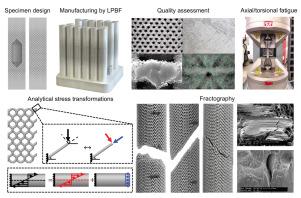Torsional and axial tension/compression fatigue behavior of Ti-6Al-4V diamond lattices produced by Laser Powder Bed Fusion (LPBF)
IF 6.8
2区 材料科学
Q1 ENGINEERING, MECHANICAL
引用次数: 0
Abstract
The increasing importance to characterize additively manufactured lattice structures in different load regimes cannot be overemphasized due to their robust load bearing applications in lightweight structural parts or biomedical implants. This study investigates the torsional fatigue behavior of metallic diamond cell structures to check the mean stress sensitivity of these meta-materials. Consistency in results for torsional fatigue is achieved by a unique sample design that minimizes stress concentration, is self-centering and graded. In addition, axial fatigue in tension–tension, compression–compression and tension–compression is studied. The tensile mode is found to be most detrimental to fatigue life of all axial modes. An analytical local stress method (LSM) is presented to estimate the maximum local stresses that occur in the structure. By using this approach, axial tension/compression and torsion fatigue experiments almost fall together due to the similar maximum local stress. Reverse calculations from these local stress curves can provide valuable insight into torsional strength when data are available only for axial fatigue tests.

激光粉末床熔合Ti-6Al-4V金刚石晶格的扭转和轴向拉伸/压缩疲劳行为
由于增材制造的晶格结构在轻质结构部件或生物医学植入物中具有强大的承载应用,因此在不同负载情况下表征其日益增加的重要性再怎么强调也不为过。本文研究了金属金刚石细胞结构的扭转疲劳行为,以检验这些超材料的平均应力敏感性。扭转疲劳结果的一致性是通过独特的样品设计实现的,该设计最大限度地减少了应力集中,是自定心和分级的。此外,还研究了拉伸-拉伸、压缩-压缩和拉伸-压缩的轴向疲劳。在所有轴向模态中,拉伸模态对疲劳寿命最不利。提出了一种估算结构中最大局部应力的解析局部应力法(LSM)。采用这种方法,由于最大局部应力相似,轴向拉伸/压缩和扭转疲劳试验几乎同时进行。当数据仅用于轴向疲劳试验时,通过这些局部应力曲线的反向计算可以提供有价值的扭转强度信息。
本文章由计算机程序翻译,如有差异,请以英文原文为准。
求助全文
约1分钟内获得全文
求助全文
来源期刊

International Journal of Fatigue
工程技术-材料科学:综合
CiteScore
10.70
自引率
21.70%
发文量
619
审稿时长
58 days
期刊介绍:
Typical subjects discussed in International Journal of Fatigue address:
Novel fatigue testing and characterization methods (new kinds of fatigue tests, critical evaluation of existing methods, in situ measurement of fatigue degradation, non-contact field measurements)
Multiaxial fatigue and complex loading effects of materials and structures, exploring state-of-the-art concepts in degradation under cyclic loading
Fatigue in the very high cycle regime, including failure mode transitions from surface to subsurface, effects of surface treatment, processing, and loading conditions
Modeling (including degradation processes and related driving forces, multiscale/multi-resolution methods, computational hierarchical and concurrent methods for coupled component and material responses, novel methods for notch root analysis, fracture mechanics, damage mechanics, crack growth kinetics, life prediction and durability, and prediction of stochastic fatigue behavior reflecting microstructure and service conditions)
Models for early stages of fatigue crack formation and growth that explicitly consider microstructure and relevant materials science aspects
Understanding the influence or manufacturing and processing route on fatigue degradation, and embedding this understanding in more predictive schemes for mitigation and design against fatigue
Prognosis and damage state awareness (including sensors, monitoring, methodology, interactive control, accelerated methods, data interpretation)
Applications of technologies associated with fatigue and their implications for structural integrity and reliability. This includes issues related to design, operation and maintenance, i.e., life cycle engineering
Smart materials and structures that can sense and mitigate fatigue degradation
Fatigue of devices and structures at small scales, including effects of process route and surfaces/interfaces.
 求助内容:
求助内容: 应助结果提醒方式:
应助结果提醒方式:


